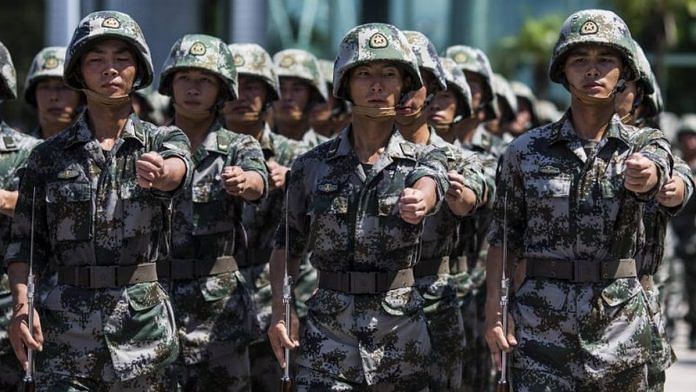New Delhi: Fresh satellite images have emerged Wednesday, raising concerns of increased Chinese troop build-up in the Galwan Valley, even as India and China deploy additional troops in the Depsang plains near the northern-most part of the Line of Actual Control (LAC).
The new images emerged on a day when China launched a twin verbal onslaught against India, with its foreign and defence ministries blaming New Delhi for the deadly Galwan Valley clash on 15 June, and for violating bilateral agreements, international rules and provoking the clash.
The satellite images of Galwan Valley, dated 22 June and put out by Twitter handle @detresfa_, which has been releasing images since the tensions began building in early May, show a massive build-up of China’s People’s Liberation Army troops since the 15 June clash, in which 20 Indian soldiers lost their lives near patrol point 14 on the Indian side of the LAC.
Images via @Maxar of the #GalwanValley face-off point on 22 June 2020 show possible defensive positions being set up by #China, small walls, trench type areas have now appeared on site #IndiaChinaFaceOff pic.twitter.com/5PClz8qKEz
— d-atis☠️ (@detresfa_) June 24, 2020
Although the Army is yet to speak officially on the latest satellite images, sources told ThePrint that the camps visible are on the Chinese side of the Galwan Valley, close to the LAC.
“The build-up is on the Chinese side and not on Indian territory. After the corps commander-level talks on 22 June, a decision has been taken to de-escalate in a phased manner, which will also include areas close to the LAC,” a source told ThePrint.
India and China agreed on “step-wise mutual disengagement” from all areas of friction in eastern Ladakh at Monday’s 11-hour-long corps commanders’ meeting.
However, the speed and time-table for de-escalation at each location will be different.
Sources maintain that the main problem area is Pangong lake, where the Chinese have come 8 km inside the LAC on the Indian side, and dug in at ‘Finger 4’.
Also read: How Indian troops chased the Chinese for a kilometre over LAC in Galwan on 15 June night
Show of strength in Depsang
Sources said another area where India and China have both increased deployment is the Depsang plains. The Chinese have deployed additional tanks and moved them slightly forward from their usual positions, but they are still away from the LAC.
Sources said when the crisis first broke out in early May, India had anticipated that China might flex its muscles in this crucial area, and carried out advance deployment.
When asked about inputs suggesting that some units of the PLA have actually moved a few kilometres into what is locally known as “bottleneck area” on the Indian side, Army sources said they “have no such reports”.
Meanwhile, another set of Army sources said the forward deployment by China is within territory controlled by them.
There had also been inputs that said patrolling by Indian soldiers to Patrol Point 11, 12 and 13 in the Depsang area had been challenged by the Chinese.
In April 2013, Chinese troops had crossed into the Indian territory and pitched tents for three weeks in Raki Nula, 30 km south of strategic air base Daulat Beg Oldi, before they agreed to pull out.
Also read: Want to help Indian soldiers at LAC? Stop spreading assumptions about Galwan clash




Indian Army knows what is to be done . Please do not worry about that. One request – Please do not raise the pitch because then you are perceived as a tool of psychological warfare for Chinese.